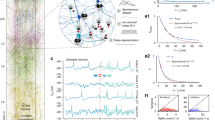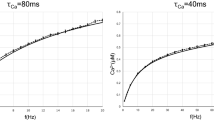Abstract
Characterizing the responsiveness of thalamic neurons is crucial to understanding the flow of sensory information. Typically, thalamocortical neurons possess two distinct firing modes. At depolarized membrane potentials, thalamic cells fire single action potentials and faithfully relay synaptic inputs to the cortex. At hyperpolarized potentials, the activation of T-type calcium channels promotes burst firing, and the transfer is less accurate. Our results suggest that this duality no longer holds if synaptic background activity is taken into account. By injecting stochastic conductances into guinea-pig thalamocortical neurons in slices, we show that the transfer function of these neurons is strongly influenced by conductance noise. The combination of synaptic noise with intrinsic properties gives a global responsiveness that is more linear, mixing single-spike and burst responses at all membrane potentials. Because in thalamic neurons, background synaptic input originates mainly from cortex, these results support a determinant role of corticothalamic feedback during sensory information processing.
This is a preview of subscription content, access via your institution
Access options
Subscribe to this journal
Receive 12 print issues and online access
$209.00 per year
only $17.42 per issue
Buy this article
- Purchase on Springer Link
- Instant access to full article PDF
Prices may be subject to local taxes which are calculated during checkout






Similar content being viewed by others
References
Erisir, A., Van Horn, S.C. & Sherman, S.M. Relative numbers of cortical and brainstem inputs to the lateral geniculate nucleus. Proc. Natl. Acad. Sci. USA 94, 1517–1520 (1997).
Van Horn, S.C., Erisir, A. & Sherman, S.M. Relative distribution of synapses in the A-laminae of the lateral geniculate nucleus of the cat. J. Comp. Neurol. 416, 509–520 (2000).
Sherman, S.M. & Koch, C. The control of retinogeniculate transmission in the mammalian lateral geniculate nucleus. Exp. Brain Res. 63, 1–20 (1986).
Koch, C. The action of the corticofugal pathway on sensory thalamic nuclei: a hypothesis. Neuroscience 23, 399–406 (1987).
Ahissar, E., Haidarliu, S. & Zacksenhouse, M. Decoding temporally encoded sensory input by cortical oscillations and thalamic phase comparators. Proc. Natl. Acad. Sci. USA 94, 11633–11638 (1997).
Sherman, S.M. Tonic and burst firing: dual modes of thalamocortical relay. Trends Neurosci. 24, 122–126 (2001).
Sillito, A.M. & Jones, H.E. Corticothalamic interactions in the transfer of visual information. Phil. Trans. R. Soc. Lond. B 357, 1739–1752 (2002).
McCormick, D.A. & Bal, T. Sleep and arousal: thalamocortical mechanisms. Annu. Rev. Neurosci. 20, 185–215 (1997).
Jahnsen, H. & Llinas, R. Electrophysiological properties of guinea-pig thalamic neurones: an in vitro study. J. Physiol. (Lond.) 349, 205–226 (1984).
Llinas, R.R. The intrinsic electrophysiological properties of mammalian neurons: insights into central nervous system function. Science 242, 1654–1664 (1988).
Le Masson, G., Renaud-Le Masson, S., Debay, D. & Bal, T. Feedback inhibition controls spike transfer in hybrid thalamic circuits. Nature 417, 854–858 (2002).
Steriade, M. Impact of network activities on neuronal properties in corticothalamic systems. J. Neurophysiol. 86, 1–39 (2001).
Destexhe, A., Rudolph, M. & Pare, D. The high-conductance state of neocortical neurons in vivo. Nat. Rev. Neurosci. 4, 739–751 (2003).
Ho, N. & Destexhe, A. Synaptic background activity enhances the responsiveness of neocortical pyramidal neurons. J. Neurophysiol. 84, 1488–1496 (2000).
Anderson, J.S., Lampl, I., Gillespie, D.C. & Ferster, D. The contribution of noise to contrast invariance of orientation tuning in cat visual cortex. Science 290, 1968–1972 (2000).
Chance, F.S., Abbott, L.F. & Reyes, A.D. Gain modulation from background synaptic input. Neuron 35, 773–782 (2002).
Shu, Y., Hasenstaub, A., Badoual, M., Bal, T. & McCormick, D.A. Barrages of synaptic activity control the gain and sensitivity of cortical neurons. J. Neurosci. 23, 10388–10401 (2003).
Larkum, M.E., Senn, W. & Luscher, H.R. Top-down dendritic input increases the gain of layer 5 pyramidal neurons. Cereb. Cortex 14, 1059–1070 (2004).
Contreras, D., Timofeev, I. & Steriade, M. Mechanisms of long-lasting hyperpolarizations underlying slow sleep oscillations in cat corticothalamic networks. J. Physiol. 494, 251–264 (1996).
Wilson, J.R., Friedlander, M.J. & Sherman, S.M. Fine structural morphology of identified X- and Y-cells in the cat's lateral geniculate nucleus. Proc. R. Soc. Lond. B 221, 411–436 (1984).
Liu, X.B., Honda, C.N. & Jones, E.G. Distribution of four types of synapse on physiologically identified relay neurons in the ventral posterior thalamic nucleus of the cat. J. Comp. Neurol. 352, 69–91 (1995).
Sherman, S.M. & Guillery, R.W. The role of the thalamus in the flow of information to the cortex. Phil. Trans. R. Soc. Lond. B 357, 1695–1708 (2002).
Steriade, M., Jones, E.G. & McCormick, D.A. Thalamus Vol. 1 (Elsevier, Amsterdam, 1997).
Destexhe, A., Neubig, M., Ulrich, D. & Huguenard, J. Dendritic low-threshold calcium currents in thalamic relay cells. J. Neurosci. 18, 3574–3588 (1998).
Destexhe, A. & Sejnowski, T.J. The initiation of bursts in thalamic neurons and the cortical control of thalamic sensitivity. Phil. Trans. R. Soc. Lond. B 357, 1649–1657 (2002).
Prinz, A.A., Abbott, L.F. & Marder, E. The dynamic clamp comes of age. Trends Neurosci. 27, 218–224 (2004).
Destexhe, A., Rudolph, M., Fellous, J.M. & Sejnowski, T.J. Fluctuating synaptic conductances recreate in vivo-like activity in neocortical neurons. Neuroscience 107, 13–24 (2001).
Sillito, A.M., Jones, H.E., Gerstein, G.L. & West, D.C. Feature-linked synchronization of thalamic relay cell firing induced by feedback from the visual cortex. Nature 369, 479–482 (1994).
McCormick, D.A. & Feeser, H.R. Functional implications of burst firing and single spike activity in lateral geniculate relay neurons. Neuroscience 39, 103–113 (1990).
Perez-Reyes, E. Molecular physiology of low-voltage-activated t-type calcium channels. Physiol. Rev. 83, 117–161 (2003).
Troy, J.B. & Robson, J.G. Steady discharges of X and Y retinal ganglion cells of cat under photopic illuminance. Vis. Neurosci. 9, 535–553 (1992).
Turner, J.P., Leresche, N., Guyon, A., Soltesz, I. & Crunelli, V. Sensory input and burst firing output of rat and cat thalamocortical cells: the role of NMDA and non-NMDA receptors. J. Physiol. (Lond.) 480, 281–295 (1994).
Usrey, W.M., Reppas, J.B. & Reid, R.C. Paired-spike interactions and synaptic efficacy of retinal inputs to the thalamus. Nature 395, 384–387 (1998).
Lu, S.M., Guido, W. & Sherman, S.M. Effects of membrane voltage on receptive field properties of lateral geniculate neurons in the cat: contributions of the low-threshold Ca2+ conductance. J. Neurophysiol. 68, 2185–2198 (1992).
Ramcharan, E.J., Gnadt, J.W. & Sherman, S.M. Burst and tonic firing in thalamic cells of unanesthetized, behaving monkeys. Vis. Neurosci. 17, 55–62 (2000).
Weyand, T.G., Boudreaux, M. & Guido, W. Burst and tonic response modes in thalamic neurons during sleep and wakefulness. J. Neurophysiol. 85, 1107–1118 (2001).
Leresche, N., Hering, J. & Lambert, R.C. Paradoxical potentiation of neuronal T-type Ca2+ current by ATP at resting membrane potential. J. Neurosci. 24, 5592–5602 (2004).
Hirsch, J.C., Fourment, A. & Marc, M.E. Sleep-related variations of membrane potential in the lateral geniculate body relay neurons of the cat. Brain Res. 259, 308–312 (1983).
Guido, W. & Weyand, T. Burst responses in thalamic relay cells of the awake behaving cat. J. Neurophysiol. 74, 1782–1786 (1995).
Steriade, M. To burst, or rather, not to burst. Nat. Neurosci. 4, 671 (2001).
Reinagel, P., Godwin, D., Sherman, S.M. & Koch, C. Encoding of visual information by LGN bursts. J. Neurophysiol. 81, 2558–2569 (1999).
Lewis, J.E. Sensory processing and the network mechanisms for reading neuronal population codes. J. Comp. Physiol. A 185, 373–378 (1999).
Barber, M.J., Clark, J.W. & Anderson, C.H. Neural representation of probabilistic information. Neural Comput. 15, 1843–1864 (2003).
Tanaka, K. Organization of geniculate inputs to visual cortical cells in the cat. Vision Res. 25, 357–364 (1985).
Alonso, J.M., Usrey, W.M. & Reid, R.C. Precisely correlated firing in cells of the lateral geniculate nucleus. Nature 383, 815–819 (1996).
Montero, V.M. Amblyopia decreases activation of the corticogeniculate pathway and visual thalamic reticularis in attentive rats: a 'focal attention' hypothesis. Neuroscience 91, 805–817 (1999).
Hines, M.L. & Carnevale, N.T. The NEURON simulation environment. Neural Comput. 9, 1179–1209 (1997).
Destexhe, A., Mainen, Z.F. & Sejnowski, T.J. Kinetic models of synaptic transmission. in Methods in Neuronal Modeling 2nd edn. (eds. Koch, C. & Segev, I.) Ch. 1, 1–26 (MIT Press, Cambridge, Massachusetts, 1998).
Rudolph, M., Piwkowska, Z., Badoual, M., Bal, T. & Destexhe, A. A method to estimate synaptic conductances from membrane potential fluctuations. J. Neurophysiol. 91, 2884–2896 (2004).
Acknowledgements
We thank M. Rudolph, G. Sadoc and L. Focsa for help with computation and Z. Piwkowska and D. Shulz for comments on the manuscript. This work was supported by the Centre National de la Recherche Scientifique, the Human Frontier Science Program, the European Commission (IST-2001-34712) and the Action Concertée Initiative 'Neurosciences integratives et computationnelles'. J.W. is the recipient of a European Union Marie Curie fellowship.
Author information
Authors and Affiliations
Corresponding authors
Ethics declarations
Competing interests
The authors declare no competing financial interests.
Supplementary information
Supplementary Fig. 1
Subthreshold response variability of thalamocortical cells at hyperpolarized potential (Hyp) and 5 Hz random strength stimulation. (PDF 885 kb)
Supplementary Fig. 2
Comparison of pre-response potential and background conductances preceding burst and single spike responses during noise recordings at resting potential. (PDF 758 kb)
Supplementary Fig. 3
Test of the dynamic-clamp method by comparing real and model membrane potential fluctuations. (PDF 826 kb)
Rights and permissions
About this article
Cite this article
Wolfart, J., Debay, D., Le Masson, G. et al. Synaptic background activity controls spike transfer from thalamus to cortex. Nat Neurosci 8, 1760–1767 (2005). https://doi.org/10.1038/nn1591
Received:
Accepted:
Published:
Issue Date:
DOI: https://doi.org/10.1038/nn1591
This article is cited by
-
Neural circuits underlying auditory contrast gain control and their perceptual implications
Nature Communications (2020)
-
Locus coeruleus activation enhances thalamic feature selectivity via norepinephrine regulation of intrathalamic circuit dynamics
Nature Neuroscience (2019)
-
Cortical drive and thalamic feed-forward inhibition control thalamic output synchrony during absence seizures
Nature Neuroscience (2018)
-
Coding of time-dependent stimuli in homogeneous and heterogeneous neural populations
Journal of Computational Neuroscience (2018)
-
Stimulus-dependent synchronization in delayed-coupled neuronal networks
Scientific Reports (2016)



